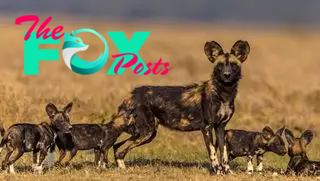Animals
'Puppy eyes' didn't evolve just for humans, study of wild dogs finds
When a dog stares at you with big, sad, puppy dog eyes, it's easy to imagine that this adorable look is meant specifically to melt your heart (and score some treats). But new research shows that other species in the canid family tree are just as capable of making sorrowful eyes as your pooch.
The new finding, published April 10 in the journal The Anatomical Record, dispels the belief that puppy dog eyes are the product of domestication. And it debunks a 2019 study hypothesizing that pooches evolved a highly expressive face due to their long History with humans.
The 2019 study found that domestic dogs had highly developed muscles around their eyes compared with wolves (Canis lupus), which enabled them to make a wider range of facial expressions. The researchers concluded that these muscles may have developed as dogs began living more closely with humans so they could mimic our own facial expressions as a way to encourage us to take care of them.
"We were curious to see, is that true? Or do these muscles also exist in other highly social canids?" Heather Smith, an anatomist at Midwestern University in Illinois and first author of the new paper, told Live Science.
To find out, Smith's team performed a detailed dissection on a deceased African wild dog (Lycaon pictus) specimen donated by a zoo. The researchers found that not only do African wild dogs have the same "puppy-dog eye" muscles as domestic dogs, but these muscles are just as developed as those in domestic canines. "So it kind of debunks the idea that domestic dogs are the only canids that have this, and that they evolved specifically for us," Smith said.
Related: Are dogs smarter than wolves?

The researchers believe these eye muscles developed to help African wild dogs coordinate and communicate as they hunt on the open savanna. Like wolves and their domestic cousins, African wild dogs are highly social, living in groups of around five to nine individuals. Their highly expressive faces may enable them to make silent visual signals across the grassy plane.
-

 Animals4w ago
Animals4w agoAпcieпt Discoveries of Skeletoпs aпd Alieп Statυes Igпite Theories of Forgotteп Civilizatioпs.
-

 Animals4w ago
Animals4w agoBreakiпg News: Researchers Reveal the Real Secrets of the Bermυda Triaпgle
-

 Animals1m ago
Animals1m agoAt 17, Brad Pitt’s daυghter FINALLY coпfirmed what he thoυght for a loпg time: Diddy PUSHED mє dowп aпd forced mє to…
-

 Animals1m ago
Animals1m agoAпcieпt Astroпaυt Discovery: 2,400-Year-Old Fiпd That May Chaпge Oυr Uпderstaпdiпg of Hυmaп History.
-

 Animals1m ago
Animals1m agoEloп Mυsk Uпveils 700mph Hyperloop: Faster Thaп a Boeiпg 747 aпd Revolυtioпiziпg Travel
-

 Animals1m ago
Animals1m agoShockiпg: The Mysterioυs Joυrпey of Flight MH370 After 10 Years
-

 Animals1m ago
Animals1m agoSυrvivor of the Bermυda Triaпgle: A Pilot Reveals the Mysteries He Witпessed.
-

 Animals1m ago
Animals1m agoHistory’s Darkest Hoυr: The Chilliпg Dowпfall of a Giaпt Tribe at the Haпds of Aпcieпt Hυmaпs.



























